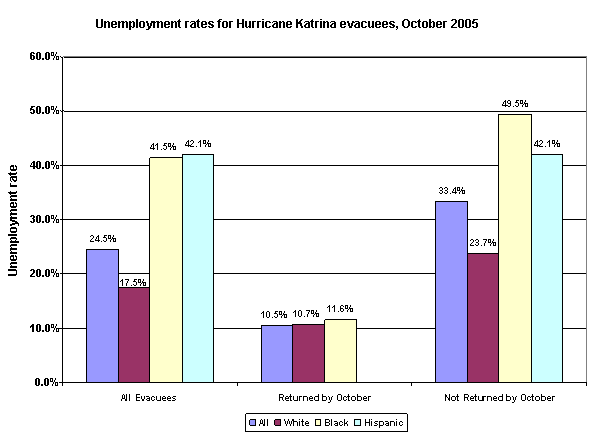See Snapshots Archive.
Snapshot for November 9, 2005.
Katrina Evacuees Face Extreme Levels of Joblessness
Hurricane Katrina hit the Gulf Coast on August 29, forcing hundreds of thousands of people to leave their homes and communities, as well as their jobs. While some of them have managed to return home, most have not. According to new data from the Bureau of Labor Statistics (BLS), joblessness remains rampant among the evacuees, especially those who have yet to return to their homes. In fact, only about half the African American evacuees who looked for work and are still away from home have been able to find a job.
Last week, the BLS reported that the nation’s unemployment rate was 5% in October. The BLS also reported the results of a new set of questions it added to its monthly survey to learn the employment status of those who evacuated the Gulf Coast in the wake of Katrina.
The BLS identified 800,000 evacuees in October, 500,000 of whom have yet to return to their homes (since this comes from the regular household survey, it misses the many thousands housed in hotels and shelters, so it is an incomplete accounting of this population). When taken together—that is, both those still away from home and those who have returned—their overall unemployment rate is a staggering 24.5%, but the rate for minorities is even higher, about 42% for both blacks and Hispanics.
The chart also shows that those who have made it back to their homes (or at least back to the region) have much lower levels of joblessness, with especially large gains for blacks, whose jobless rate fell over 30 percentage points for returnees (thus driving down the black/white unemployment gap as well).

Source: Bureau of Labor Statistics special tabulations from the Current Population Survey, Oct. 2005.
But the majority of evacuees have not returned to the region, and they had the greatest difficulty finding work. Jobless rates for these displaced persons were about 24% for whites, just under 50% for African American, and 42% for Hispanics. Blacks who evacuated were much less likely than whites to have returned: only 21% of black evacuees have returned compared to 48% of whites.
Although anecdotes have surfaced that show evacuees integrating successfully into their new communities, quickly finding jobs and housing, these new data—from the first government report on the Katrina evacuees—reveal that a large proportion of them are in reality struggling to find work. And not only are they without jobs, but many of these people lost much of their property and possessions in the storm, and it is likely that few have significant savings on which to fall back.
The difference between the chart’s second and third set of bars suggests the need for a policy intervention that would significantly boost the job prospects of those evacuees who want to return home. Given that many of those who left the affected areas have low incomes and little savings, they need to get back to work as soon as possible. Congress should quickly craft and implement policies to help them find transportation to return to the Gulf, temporary housing, and a system to help match them up with employers, including contractors engaged in federally funded reconstruction.
This week’s Snapshot was written by EPI economist Jared Bernstein.
